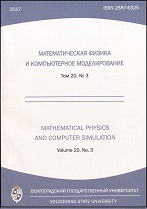|
Modeling, informatics and management
On the use of the Wilcoxon criterion in the practice of pedagogical research
E. V. Bondareva, E. A. Mazepa
Volgograd State University
Abstract:
The article discusses the use of nonparametric measures of in uence in pedagogical research. The Wilcoxon criterion for comparing indicators obtained as a result of measurements in a connected sample is highlighted. The necessary conditions for the application of the criterion, as well as the advantages of its use are indicated. The possibility of using the Wilcoxon criterion is illustrated by the example of determining the e ectiveness of the proposed teaching methodology using the Uchi.ru online platform in educational activities. Most modern studies in the eld of pedagogy and psychology, along with qualitative descriptions of the results of the research, actively use quantitative analysis. Last analysis includes processing of the data using methods of mathematical statistics. In order to show the e ectiveness of the developed methodology for the learning process, it should be considered as a factor in uencing changes in the studied trait. Further study of these changes allows the researcher to determine the statistical reliability (signi cance) of the in uence of the factor under consideration. The subsequent analysis of the reliability of the in uence of a particular factor, the comparison of the measure of in uence of various factors is carried out using parametric (variance analysis) and nonparametric measures of in uence (the sign criterion, the Wilcoxon criterion). This article discusses the use of nonparametric measures of in uence in pedagogical research. The Wilcoxon criterion is selected for comparing the indicators obtained as a result of measurement in a connected sample and allowing to diagnose not only the direction of changes, but also their severity. The necessary conditions for the application of the criterion, as well as the advantages of its use, are indicated. The possibility of using the Wilcoxon criterion is illustrated by the example of determining the e ectiveness of the proposed teaching methodology using the Uchi.ru online platform in educational activities. Conclusions are made about its ine ciency for mastering the material in mathematics for younger schoolchildren.
Keywords:
nonparametric measures of in uence, connected sample, rank sum, Wilcoxon test, Z-test.
Received: 14.06.2021
Citation:
E. V. Bondareva, E. A. Mazepa, “On the use of the Wilcoxon criterion in the practice of pedagogical research”, Mathematical Physics and Computer Simulation, 24:3 (2021), 26–32
Linking options:
https://www.mathnet.ru/eng/vvgum311 https://www.mathnet.ru/eng/vvgum/v24/i3/p26
|

| Statistics & downloads: |
| Abstract page: | 84 | | Full-text PDF : | 37 |
|




 Contact us:
Contact us: Terms of Use
Terms of Use
 Registration to the website
Registration to the website Logotypes
Logotypes








 Citation in format
Citation in format 